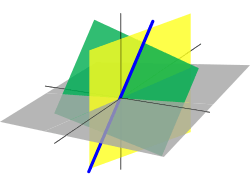Transpose of a linear map
In linear algebra, the transpose of a linear map between two vector spaces, defined over the same field, is an induced map between the dual spaces of the two vector spaces. The transpose of a linear map is often used to study the original linear map. This concept is generalised by adjoint functors.
Definition
Let V and W be vector spaces over the same field. If f : V → W is a linear map, then the transpose[1] (or dual, or adjoint[2]), is defined to be
The resulting functional tf(φ) is called the pullback of φ along f.
The following identity, which characterises the transpose,[3] holds for all φ ∈ W∗ and v ∈ V:
where the bracket [·,·]V is the natural pairing of V's dual space with V, and [·,·]W is the same with W.
Properties
The assignment f ↦ tf produces an injective linear map between the space of linear operators from V to W and the space of linear operators from W∗ to V∗. If V = W then the space of linear maps is an algebra under composition of maps, and the assignment is then an antihomomorphism of algebras, meaning that t(fg) = tg tf. In the language of category theory, taking the dual of vector spaces and the transpose of linear maps is therefore a contravariant functor from the category of vector spaces over F to itself. Note that one can identify t(tf) with f using the natural injection into the double dual.
Representation as a matrix
If the linear map f is represented by the matrix A with respect to two bases of V and W, then tf is represented by the transpose matrix AT with respect to the dual bases of W∗ and V∗, hence the name. Alternatively, as f is represented by A acting on the left on column vectors, tf is represented by the same matrix acting on the right on row vectors. These points of view are related by the canonical inner product on Rn, which identifies the space of column vectors with the dual space of row vectors.
Relation to the Hermitian adjoint
The identity that characterizes the transpose, that is, [f∗(φ), v] = [φ, f(v)], is formally similar to the definition of the Hermitian adjoint, however, the transpose and the Hermitian adjoint are not the same map. The difference stems from the fact that transpose is defined by a bilinear form while the Hermitian adjoint is defined by a sesquilinear form. Furthermore, while the transpose can be defined on any vector space, the Hermitian adjoint is defined on Hilbert spaces.
If X and Y are Hilbert spaces and u : X → Y is a linear map then the transpose of u and the Hermitian adjoint of u, which we will denote respectively by tu and u∗, are related. Denote by I : X → X∗ and J : Y → Y∗ the canonical antilinear isometries of the Hilbert spaces X and Y onto their duals. Then u∗ is the following composition of maps:[5]
Applications to functional analysis
Suppose that X and Y are topological vector spaces and that u : X → Y is a linear map, then many of u's properties are reflected in u∗.
See also
Notes
References
- Halmos, Paul (1974), Finite-dimensional Vector Spaces, Springer, ISBN 0-387-90093-4
- Schaefer, Helmuth H.; Wolff, M.P. (1999). Topological Vector Spaces. GTM. 3. New York: Springer-Verlag. ISBN 9780387987262.
- Trèves, François (1995). Topological Vector Spaces, Distributions and Kernels. Dover Publications. ISBN 9780486453521.
